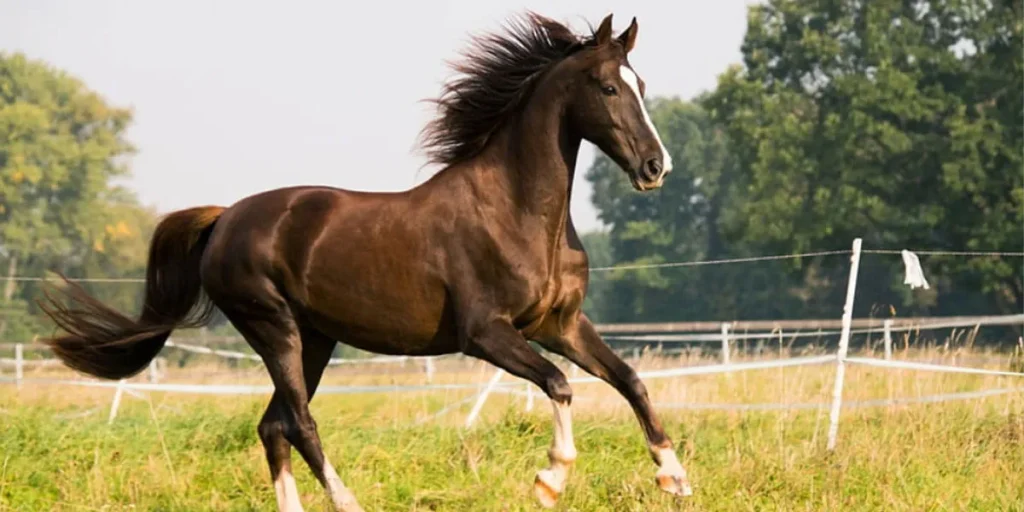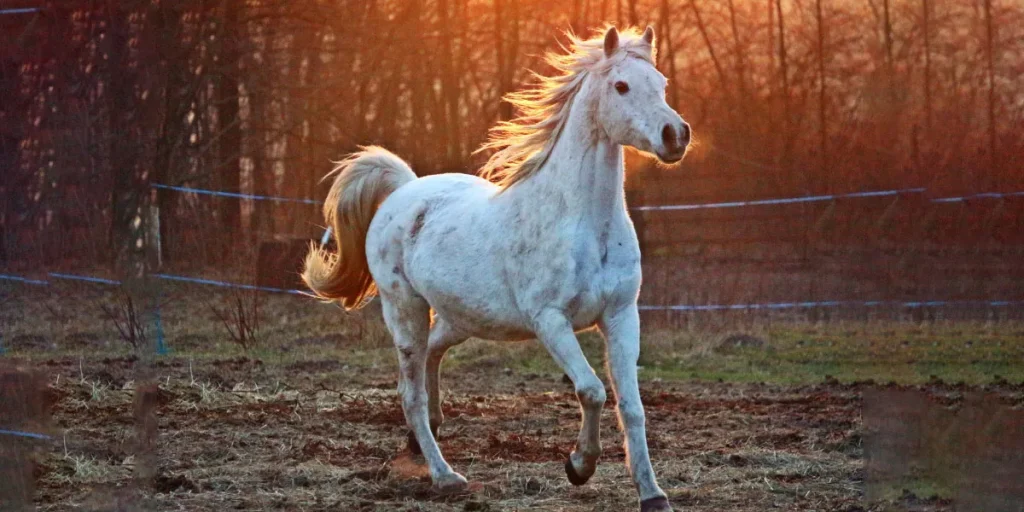A horse typically weighs between 900 and 2,200 pounds. The breed and age greatly influence its weight.
Horses have captivated humans for centuries with their grace, strength, and companionship.
Understanding a horse’s weight is crucial for proper care, including feeding, exercise, and healthcare.
The equine industry, encompassing sport, leisure, and work, places great emphasis on horse health, where weight plays a key role.
Horse enthusiasts, owners, and veterinarians closely monitor weight to ensure optimal well-being.
With breeds ranging from the petite Falabella to the majestic Clydesdale, the diversity of horses is mirrored in their varying weights.
This weight spectrum allows them to fulfill a variety of roles, from racing to therapy, highlighting their importance in multiple spheres of human life.

What Factors Into A Horse’s Weight?
Imagine a horse, powerful and graceful. These majestic creatures come in various sizes. Yet, ever wondered why?
Just like humans, many things affect a horse’s weight. From their breed and age to what they eat every day.
Let’s trot through the major factors influencing how heavy these animals can be.
Breeds And Variations In Size
Horses come in many breeds, each with its own size. For instance, a Shetland pony weighs less than a big Clydesdale. Here’s a quick look at how different breeds stack up:
| Breed | Average Weight |
|---|---|
| Miniature Horse | 150-350 pounds |
| Shetland Pony | 400-450 pounds |
| Arabian | 800-1,000 pounds |
| Thoroughbred | 1,000-1,200 pounds |
| Clydesdale | 1,800-2,000 pounds |
- Miniature horses are the lightest.
- Draft breeds like Clydesdales top the scales.
Age And Development
A horse’s age affects its weight. Young foals grow quickly, gaining hundreds of pounds in a year. Mature horses maintain a steadier weight. Let’s see how they grow in stages:
- Birth to 6 months: Rapid growth spurt.
- 6 months to 2 years: Steady growth but at a slower pace.
- 2 years and up: Most reach full weight by this age.
Nutrition and exercise matter too. Horses need a balanced diet and regular workouts to stay fit and healthy. Without these, a horse can become underweight or overweight.
Measuring A Horse’s Mass

Knowing how much a horse weighs is vital. It helps in healthcare, nutrition, and sport. Different ways exist to measure a horse’s mass.
Some are old, some new. Let’s explore how people find out this hefty fact!
Traditional Weighing Methods
Farmers and vets have used simple yet clever methods for years. They can tell a horse’s weight by experience.
Sometimes, they use large scales. We call these livestock scales. But it’s not easy. Horses must stay still. Think of it as a giant bathroom scale!
- Experience-based estimation
- Livestock scales
- Visual health checks
Older techniques also include:
- Measuring body length and girth
- Using a standard weight chart
Modern Techniques
Technology brings new ways to tell a horse’s weight. Special platforms called weighbridges are in use. A horse walks onto this bridge, and it records the weight. Simple and easy!
| Tool | Description | Accuracy |
|---|---|---|
| Weighbridge | A platform scale for horses | High |
| Weight Tape | Measure around the girth area | Moderate |
An innovation is the weight tape. Wrap it around the horse’s girth. Read the number. It’s quick and quite accurate. Note that it works best on standard body shapes.
Digital scales also aid in precision. They have readouts that detail the weight to the last digit. Vets use these for accurate dosages.
- Portable digital scales
- Mobile apps with algorithms
- 3D body scanning technology
We see horses can be weighed in many ways. The old and the new help horse owners keep their animals healthy and happy.
Next time you see a horse, marvel at the tech that keeps track of its mass!
Average Weights

Welcome to the diverse world of horse sizes and weights! Like dogs, horses come in a vast range of breeds, sizes, and builds.
This unique variety means there’s no one-size-fits-all answer to how much a horse weighs.
The Lightweight Miniatures
Miniature horses might be small, but they pack a lot of charm into a tiny package. Generally, these minuscule equines weigh between:
- 150 to 350 pounds
That’s about the size of a large dog!
The Heavyweights Of The Horse World
On the opposite end, draft horses showcase sheer power and size. Famous breeds like the Belgian Draft and Shire can weigh:
| Breed | Average Weight |
|---|---|
| Belgian Draft | 1,800 to 2,200 pounds |
| Shire | 1,800 to 2,400 pounds |
Impact Of Diet And Lifestyle On Equine Weight
The weight of a horse can vary greatly, influenced by its breed, age, and size. Yet, two critical factors play a pivotal role in determining a horse’s weight: its diet and lifestyle.
An optimal balance of the right nutrients coupled with adequate exercise can ensure a horse maintains a healthy weight.
Feeding Regimens And Nutritional Balance
Just like humans, horses need a balanced diet to stay healthy. The amount and type of food given to a horse can significantly influence its weight.
Horses require a mix of hay, grains, and sometimes supplements. These must match their lifestyle and workload.
- Forage should form the basis of a horse’s diet.
- Concentrates like grains can provide extra energy for working horses.
- Vitamins and minerals need to be part of their daily intake.
Inclusion of a varied diet prevents weight issues. Overfeeding can lead to obesity, whereas underfeeding might cause weight loss. Monitoring and adjusting feed portions is crucial.
Exercise And Its Effects
Exercise is just as important as diet for a horse’s weight management. Active horses tend to have more muscle and less fat.
Regular exercise helps stimulate metabolism and maintain a healthy weight.
| Activity Level | Impact on Weight |
|---|---|
| Light exercise | Helps in moderate muscle building |
| Moderate exercise | Supports stronger muscles, uses more calories |
| Heavy exercise | Increases muscle mass, significant calorie burn |
Rest days are essential for muscle recovery. Each horse’s exercise needs differ based on their age, breed, and health. A tailor-made workout plan works best.
Consistency in their exercise routine plays a key role in keeping them at an ideal weight. In short, a horse needs the right food and the right amount of exercise to stay fit and happy.
Interlinking Aspects Of Equine Welfare
The bond between health and weight in horses is vital for their welfare. As with humans, a horse’s weight can indicate its overall health.
A well-balanced weight is a cornerstone of equine care.
Identifying Obesity And Its Risks
Recognizing obesity in horses is crucial for preventing health issues. A Body Condition Score (BCS) helps owners assess fat deposits. Scores over 7 suggest obesity.
This excess weight can lead to joint stress, metabolic disorders, and even heart strain. It is important to monitor a horse’s BCS regularly for signs of weight gain.
Maintaining An Ideal Weight: Tips For Horse Owners
Keeping horses at an ideal weight demands consistent care. Here are vital tips:
- Regular Exercise: Daily activity helps burn calories and maintain muscle tone.
- Balanced Diet: Provide a diet rich in nutrients but controlled in energy content to prevent weight gain.
- Monitor Portions: Adjust feed portions according to the horse’s activity level and health needs.
- Veterinary Check-ups: Regular veterinary visits ensure the early detection of weight-related health issues.
Creating a schedule for feeding, exercise, and veterinary care can make weight management easier. Use a weight tape monthly to track the horse’s weight.
Record-breaking Heavy Horses
Believe it or not, some horses are just huge. These living legends with their monstrous frames and thundering hooves have fascinated us for centuries.
These real-life giants, the record-breaking heavy horses, outshine even the tallest tales. Their sheer size can inspire awe in horse lovers and novices alike.
Famous Horses Through Time
Famous horses in history often come with tales of strength and size. From pulling ancient chariots to showcasing their might in medieval jousts, these historical heavyweights have paved the way for their modern descendants.
- Sampson, also known as Mammoth, born in 1846, was a shire horse that stood at an astounding 21.2 hands.
- Brooklyn Supreme, clocking in at over 3,200 pounds, was a red roan Belgian Draft horse with a reputation for size and strength.
Contemporary Record Holders
Modern times bring new champions to the arena of size. Contemporary record holders continue to amaze with their incredible weights and heights.
| Horse Name | Breed | Weight | Height |
|---|---|---|---|
| Big Jake | Belgian Draft Horse | 2,600 pounds | 20 hands 2.75 inches |
| Poe | Clydesdale | ~1,800 pounds | 20 hands 3 inches |
Not only do these heavy horses tower above the rest, but their gentle nature and powerful build continue to capture hearts and break records.
FAQs About the Weight of a Horse
What Is The Average Weight Of A Horse?
The average horse weighs between 900 to 2,000 pounds. Lighter breeds like Arabians tip the scale at around 900 pounds, while larger breeds such as Clydesdales can weigh up to 2,200 pounds. Factors like breed, age, and size affect weight.
How Does Breed Influence Horse Weight?
Horse weight varies significantly by breed. Light breeds, such as Thoroughbreds, average around 1,000 pounds, whereas heavy draft breeds, including Percherons or Belgians, can exceed 2,000 pounds. Miniature horses weigh as little as 150-350 pounds.
Can Horses Be Overweight Or Underweight?
Yes, horses can be overweight or underweight, much like humans. Overweight horses carry excess fat, which can stress their body and lead to health issues.
Conversely, underweight horses may suffer from malnutrition or underlying health problems.
What Factors Contribute To A Horse’s Weight?
A horse’s weight is influenced by breed, age, diet, and overall health. Genetics play a major role, with some breeds naturally heavier or lighter.
Proper nutrition and regular exercise are crucial in maintaining a healthy equine weight.
Conclusion
Understanding a horse’s weight is vital for proper care and management. Average weights vary significantly by breed, age, and size.
It’s essential to monitor their health through weight checks to ensure optimal well-being. Keep these factors in mind for a happy, healthy horse.
Embrace the diversity in these magnificent creatures’ sizes.
Resources:
https://www.blm.gov/whb
https://www.blm.gov/programs/wild-horse-and-burro/about-the-program/about-wild-horses-and-burros
